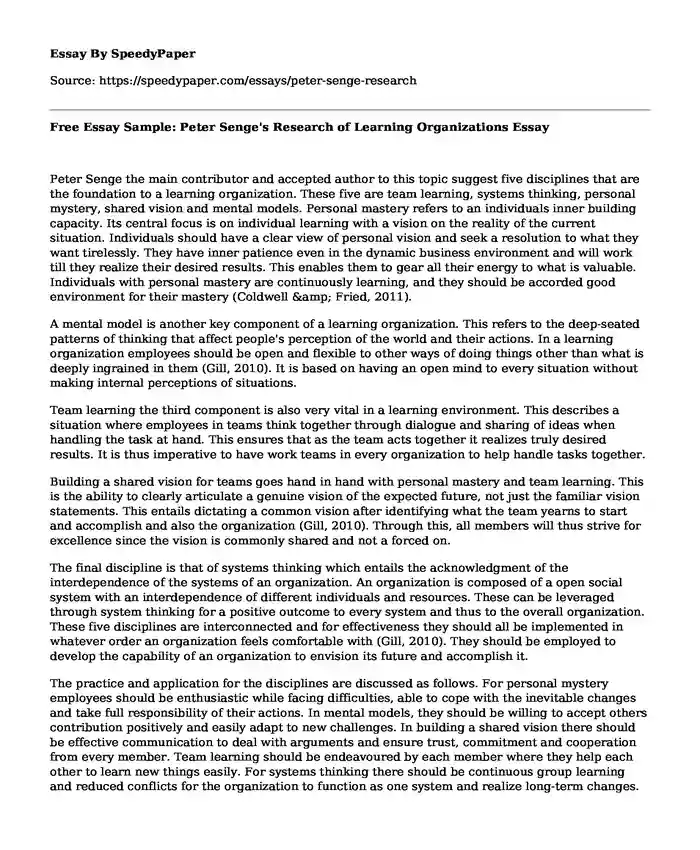Peter Senge the main contributor and accepted author to this topic suggest five disciplines that are the foundation to a learning organization. These five are team learning, systems thinking, personal mystery, shared vision and mental models. Personal mastery refers to an individuals inner building capacity. Its central focus is on individual learning with a vision on the reality of the current situation. Individuals should have a clear view of personal vision and seek a resolution to what they want tirelessly. They have inner patience even in the dynamic business environment and will work till they realize their desired results. This enables them to gear all their energy to what is valuable. Individuals with personal mastery are continuously learning, and they should be accorded good environment for their mastery (Coldwell & Fried, 2011).
A mental model is another key component of a learning organization. This refers to the deep-seated patterns of thinking that affect people's perception of the world and their actions. In a learning organization employees should be open and flexible to other ways of doing things other than what is deeply ingrained in them (Gill, 2010). It is based on having an open mind to every situation without making internal perceptions of situations.
Team learning the third component is also very vital in a learning environment. This describes a situation where employees in teams think together through dialogue and sharing of ideas when handling the task at hand. This ensures that as the team acts together it realizes truly desired results. It is thus imperative to have work teams in every organization to help handle tasks together.
Building a shared vision for teams goes hand in hand with personal mastery and team learning. This is the ability to clearly articulate a genuine vision of the expected future, not just the familiar vision statements. This entails dictating a common vision after identifying what the team yearns to start and accomplish and also the organization (Gill, 2010). Through this, all members will thus strive for excellence since the vision is commonly shared and not a forced on.
The final discipline is that of systems thinking which entails the acknowledgment of the interdependence of the systems of an organization. An organization is composed of a open social system with an interdependence of different individuals and resources. These can be leveraged through system thinking for a positive outcome to every system and thus to the overall organization. These five disciplines are interconnected and for effectiveness they should all be implemented in whatever order an organization feels comfortable with (Gill, 2010). They should be employed to develop the capability of an organization to envision its future and accomplish it.
The practice and application for the disciplines are discussed as follows. For personal mystery employees should be enthusiastic while facing difficulties, able to cope with the inevitable changes and take full responsibility of their actions. In mental models, they should be willing to accept others contribution positively and easily adapt to new challenges. In building a shared vision there should be effective communication to deal with arguments and ensure trust, commitment and cooperation from every member. Team learning should be endeavoured by each member where they help each other to learn new things easily. For systems thinking there should be continuous group learning and reduced conflicts for the organization to function as one system and realize long-term changes.
References
Barker, R. T., & Camarata, M. R. (1998). The role of communication in creating and maintaining a learning organization: Preconditions, Indicators and Disciplines. The Journal of Business Communication, 35(4), 443-467.
Coldwell, D.A., & Fried, A. (2011). Learning organizations without borders? A cross-cultural study of university HR practitioners perceptions of the salience of Senges five disciplines in effective work outcomes. International Journal of Cross Cultural Management, 12(1), 101-114.
Gill, S. J. (2010). Developing a learning culture in nonprofit organizations. Los Angeles: SAGE.
Cite this page
Free Essay Sample: Peter Senge's Research of Learning Organizations. (2019, Jun 24). Retrieved from https://speedypaper.com/essays/peter-senge-research
Request Removal
If you are the original author of this essay and no longer wish to have it published on the SpeedyPaper website, please click below to request its removal:
- Essay Example on Cystic Fibrosis
- Birth of Nation Essay Sample
- Spreadsheets Are Vulnerable to Fraud, Free Essay Sample
- Nuclear Weapons and Nuclear Politics in South Asia in a Free Essay
- Find Out the Differences Between Internal and External Labor Markets in Our Free Essay
- Free Essay for Students: The World Cup
- Paper Example. Open Banking Application Programming Interface in Hongkong
Popular categories





